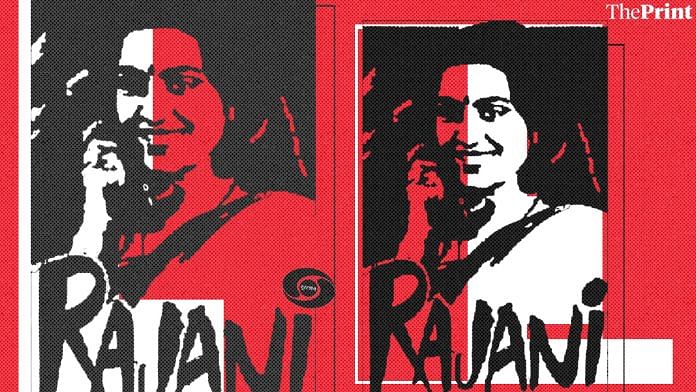Much before the onset of cable TV in our entertainment list, there was a middle-class woman called Rajani, who fought the corrupt system and solved social problems on a weekly basis.
Doordarshan’s 13-episode TV serial titled ‘Rajani’, which came out in 1985, was India’s first to depict a warrior queen for consumer rights. And this was pre-economic reforms, pre-privatisation. So, almost all the fight was against the government.
Rajani was a feisty woman, who spoke the truth fearlessly and called out injustice – as her family watched on, helpless and bemused. The sari wearing, big bindi Rajani, played by actress Priya Tendulkar, was a household name in the 1980s. If you had a problem – with school admission, telephone connection, auto rickshaw drivers – Rajani was there to fight for you. She would not hesitate to admonish powerful bureaucrats and police officers. The title track of the TV soap said it all: “There is a girl, her name is Rajani, and this is her story; when she sees evil, she bravely clashes with it; she walks on the path of truth, she won’t compromise with the truth.”
Also read: Phantom comics to political exposés: How Illustrated Weekly became a must-read
“She voiced her own opinions and had the courage to fight with the system. She was a strong lady who broke the convention that ‘a woman must be accompanied by a man to walk the tough road’,” recalled 67-year-old Prema Mendiratta, a retired bank employee, who used to watch the show every week.
Reflecting the state of affairs at government offices, Rajani the serial wove real-life situations – from the illegal LPG price hike to domestic violence and taxi mafia – to make an instant connect with the Indian television viewers of the time.
“The spontaneous, nationwide approval by the common man has elevated Rajani’s status to that of a national heroine,” wrote India Today in its special report for the magazine in 1985.
The report said that the serial, which it hailed as a “movement”, had ‘outstripped all its competitors in popularity, even the durable family drama Hum Log’.
Also read: How SS Gill, former I&B secretary, visited Mexico and came back with the idea of ‘Hum Log’
“Rajani was the first television series to prove the definite connection between the silver screen and the Indian middle class,” said brand expert Santosh Desai, who is also the managing director and chief executive of Future Brands. “A non-stereotypical middle-class housewife (sic) fought against the system in a television programme, which resulted in the real impact on the ground… She proved out to be a sort of knight-in-shining-armour.”
An entire generation of women grew up in the 1980s watching Rajani fight. In many ways, her character initiated young women into the good fight. After all, this was the decade young women campaigned in college campuses against Roop Kanwar’s sati in Rajasthan and for Shah Bano’s rights. The ubiquitous image of the activist woman (or the so-called “NGO woman”) of the 1980s was one who wore starched, broad-bordered cotton saris, tied her hair into a bun and wore a big bindi. Much of that image was drawn from Rajani.
Years later, Aamir Khan’s Satyamev Jayate on Star Plus tried to do the same by stirring social conscience of viewers. Except he was still the Bollywood star. He wasn’t the Everywoman.
Also read: Dunlopillo — the coveted foam mattress that superstars Meena Kumari & Ashok Kumar advertised
The trend of ‘bold & beautiful’
“It (Rajani) used to come on Sunday mornings. We all used to get up early and eat breakfast before it started. Though it came for just half an hour, it was always on meaningful issues with which we, as a common man, could definitely relate to,” said Mendiratta.
The newcomer, Priya Tendulkar was roped in for the role following the exit of popular Bollywood actress Padmini Kolhapure after shooting the pilot of the show.
One of the popular episodes of the show highlighted the difficulty of the middle class in receiving LPG cylinders for cooking. Those were the days when Indians use to book gas cylinders way in advance for doorstep deliveries, and wait endlessly.
The serial threw light on the illegal hike in LPG cylinder prices by delivery agents and the difficulties faced by the common public in getting cooking gas. While the episode was hailed by the audience, it touched a raw nerve of many.
The episode led Bombay-based All India LPG Distributors Federation to protest against the show that “their trade had been unjustly maligned.”
Another episode that simulated the harassment by taxi drivers instigated “500 (of them) to march to Doordarshan offices in Bombay demanding an apology for portraying cabbies as bad characters.”
Rajani’s impact was instant and quite visible. “It struck the right chord because of which Rajani will always remain a remarkable character in the history of Indian silver screen,” Desai said.
Also read: Garden Vareli ads with three Miss Indias made the everyday saree a fashion statement



